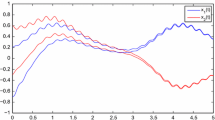Abstract
In this paper, a class of delayed cellular neural networks with unbounded activation functions and described by using space invariant cloning templates are considered. The general and explicit existing regions of equilibrium points are discussed based on dissipative theory, fixed point principle of iteration mapping and Brouwer Fixed-point Theorem. The sufficient condition is obtained to ensure the existence, uniqueness, local asymptotical stability of the equilibrium point in each saturation sub-region. Moreover, we give the condition for equilibrium point to be globally exponentially stable, and the explicit existing region of the unique equilibrium point is also located. These results extend previous works on these issues for the standard delayed cellular neural networks. Two numerical examples are given to show the validity of the obtained results.
Similar content being viewed by others
References
Chua LO, Yang L (1988) Cellular neural networks: applications. IEEE Trans Circuits Syst 35: 1273–1290
Chua LO, Roska T (1992) Cellular neural networks with nonlinear and delay-type template elements and nonunuform grids. Int J Circuit Theory Appl 20: 449–451
Chua LO, Roska T (1993) The CNN paradigm. IEEE Trans Circuits Syst 40: 147–156
Roska T, Wu C, Chua LO (1993) Stability of cellular neural networks with dominant nonlinear and delay-type templates. IEEE Trans Circuits Syst 40: 270–272
Werblin F, Roska T, Chua LO (1994) The analogical cellular neural networks as a bionic eye. Int J Circuit Theory Appl 23: 541–569
Rodriguez-Vazquez A, Espejo S, Dominguez-Castro R, Huertas J, Sanchez-Sinencio E (1993) Current-mode techniques for the implementation of continuous- and discrete-time cellular neural networks. IEEE Trans Circuits Syst II 40: 132–146
Espejo S, Carmona R, Dominguez-Castro R, Rodriguez-Vazquez A (1996) A VLSI oriented continuous time CNN model. Int J Circuit Theory Appl 24: 341–356
Ban JC, Lin SS, Hsu CH (2002) Spatial disorder of cellular neural networks with biased term. Int J Bifur Chaos Appl 12: 525–534
Hsu CH, Lin SS (2002) Spatial disorder of cellular neural networks. Jpn J Ind Appl Math 19: 143–161
Forti M, Nistri P (2003) Global convergence of neural networks with discontinuous neuron activations. IEEE Trans Circuits Syst I 50: 1421–1435
Forti M, Nistri P, Papini D (2005) Global exponential stability and global convergence in finite time of delayed neural networks with infinite gain. IEEE Trans Neural Netw 16: 1449–1463
Joy MP, Tavsanoglu V (1998) An equilibrium analysis of CNNs. IEEE Trans Circuits Syst 45: 94–98
Kaluzny P (1994) Number of stable equilibrium states of cellular neural networks. IEEE Trans Circuits Syst 41: 608–610
Wu C, Chua LO (1997) More rigorous proof of complete stability of cellular neural networks. IEEE Trans Circuits Syst 44: 370–371
Arik S, Tavsanoglu V (1998) Equilibrium analysis of delayed CNNs. IEEE Trans Circuits Syst 45: 168–171
Cao J (2001) A set of stability criteria for delayed cellular neural networks. IEEE Trans Circuits Syst 48: 494–498
Li X, Huang L (2002) On the existence of stable equilibrium points for CNNs. Diff Equ Dyn Syst 10: 53–70
Cao J, Wang J (2003) Global asymptotic stability of a general class of recurrent neural networks with time-varying delays. IEEE Trans Circuits Syst 50: 34–44
Zeng Z, Wang J, Liao X (2003) Global exponential stability of a general class of recurrent neural networks with time-varying delays. IEEE Trans Circuits Syst 50: 1353–1358
Zeng Z, Wang J, Liao X (2004) Stability analysis of delayed cellular networks described using cloning templetes. IEEE Trans Circuits Syst 51: 2313–2324
Gilli M, Biey M, Checco P (2004) Equilibrium analysis of cellular neural networks. IEEE Trans Circuits Syst 51: 903–912
Zhang Q, Wei X, Xu J (2004) An analysis on the global asymptotic stability for neural networks with variable delays. Phys Lett A 328: 163–169
Liao Z, Huang Y (2008) Horseshoe and topological entropy estimate of a class of three-dimensional cellular neural networks. Appl Math Comput 197: 382–388
Chen F, Liu Z (2003) Chaotic stationary solutions of cellular neural networks. Int J Bifur Chaos Appl 13: 3499–3504
Ban CJ, Chien PK, Lin SS, Hsu HC (2001) Spatial disorder of CNN-with asymmetric out function. Int J Bifur Chaos Appl 11: 2085–2095
Hsu HC (2000) Smale horseshoe of cellular neural networks. Int J Bifur Chaos Appl 10: 2119–2127
Liao X, Wang J (2003) Global dissipativity of continuous-time recurrent neural networks with time delay. Phys Review E 68: 1–7
Liao X, Luo Q, Zeng Z (2008) Positive invariant and global exponential attractive sets of neural networks with time-varying delays. Neurocomputing 71: 513–518
Author information
Authors and Affiliations
Corresponding author
Rights and permissions
About this article
Cite this article
Li, L., Huang, L. Equilibrium Analysis for Improved Signal Range Model of Delayed Cellular Neural Networks. Neural Process Lett 31, 177–194 (2010). https://doi.org/10.1007/s11063-010-9134-0
Published:
Issue Date:
DOI: https://doi.org/10.1007/s11063-010-9134-0




